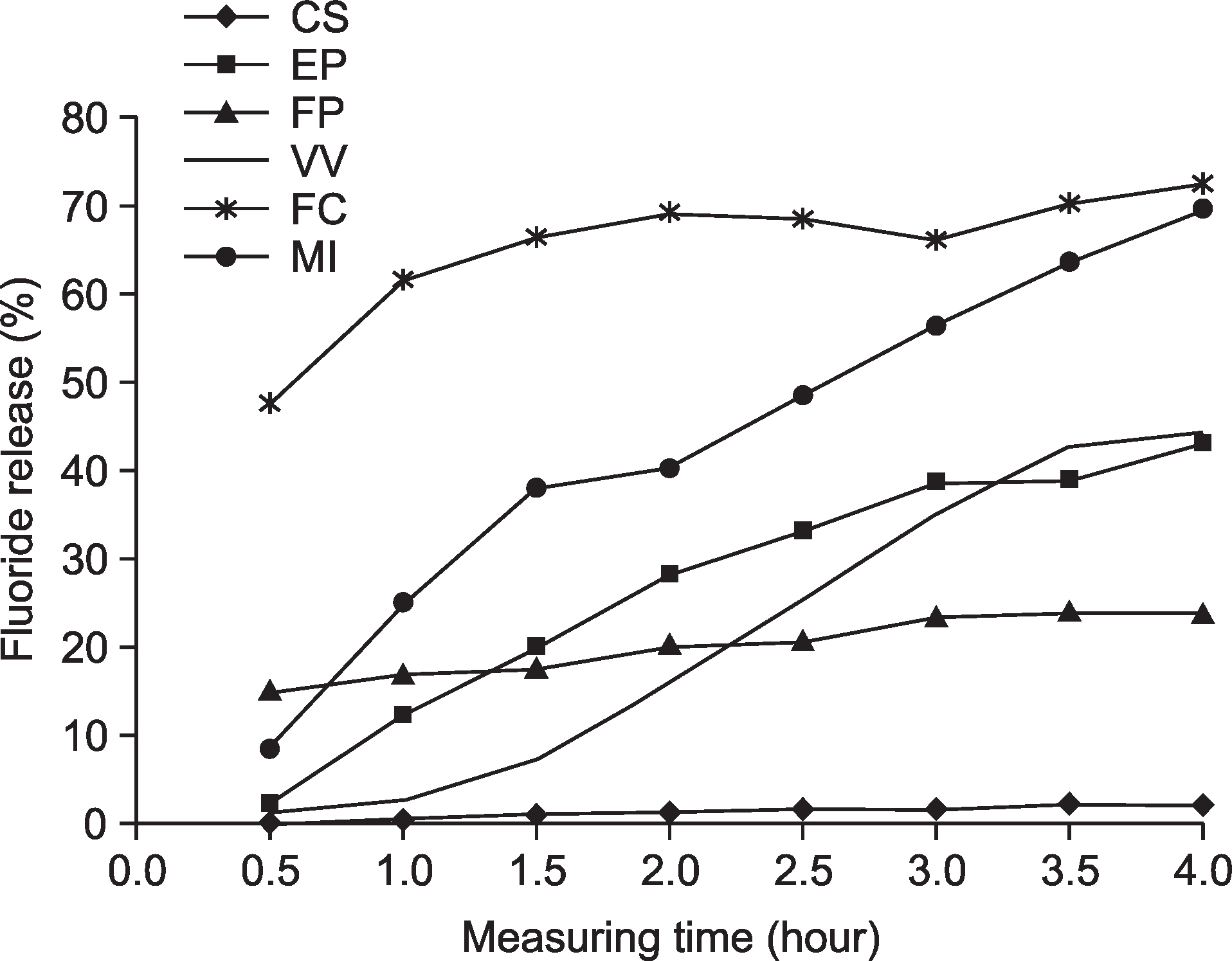J Korean Acad Oral Health.
2014 Sep;38(3):131-137. 10.11149/jkaoh.2014.38.3.131.
Evaluation of release of fluoride from dental varnishes marketed in Korea
- Affiliations
-
- 1Department of Preventive and Community Dentistry, Pusan National University School of Dentistry, Yangsan, Korea. jsh0917@pusan.ac.kr
- KMID: 2321451
- DOI: http://doi.org/10.11149/jkaoh.2014.38.3.131
Abstract
OBJECTIVES
The purpose of this study was to compare the amount and rate of cumulative fluoride released over a period of 4 h from several varnishes marketed in Korea.
METHODS
The following six commercial products were studied: cavity shield (CS, 22,600 ppm F), V varnish (VV, 22,600 ppm F), enamel pro varnish (EP, 22,600 ppm F), MI varnish (MI, 22600 ppm F), fluorine care (FC, 22600 ppm F), and fluor protector N (FP, 7700 ppm F). Five samples were collected from each varnish. Further, 10 mg of each varnish were applied onto an acrylic surface (diameter, 5 mm) and then immersed in 20 mL of distilled water at 37degrees C. The fluoride concentration in each sample was then analyzed after 30 min, 1, 2, 3, and 4 h, and after 4 days of exposure.
RESULTS
The cumulative amount of fluoride released by FC (5.64+/-1.10 ppm) was significantly higher than that released by other products after 30 min. FC (8.55+/-1.85 ppm) and MI (8.21+/-0.81 ppm) released a significantly higher cumulative amount of fluoride after 4 h. The cumulative rate of fluoride released by FC (47.80+/-9.35%) was significantly higher than that of other products after 30 min. FC (72.44+/-15.68%) and MI (69.54+/-6.88%) showed a higher cumulative fluoride release rate after 4 h. MI sustainably released fluoride after 4 h and demonstrated a high fluoride release rate of 95.76%.
CONCLUSIONS
The cumulative amount and rate of fluoride released by several varnishes were statistically significant at each time point. This data can be used by clinicians prior to selection of dental products.
Keyword
Figure
Cited by 1 articles
-
In vitro fluoride release from five different fluoride varnishes
Ji-Soo Kim, Min-Ji Byon, Yong-Tae Nam, Jin-Bom Kim, Seung-Hwa Jeong
J Korean Acad Oral Health. 2019;43(4):184-190. doi: 10.11149/jkaoh.2019.43.4.184.
Reference
-
References
1. Mckay C. A dental epidemiological study in a high fluoride area of County Fermanagh. Ulster Med J. 1974; 43:41–44.2. Ogaard B, Seppa L, Rolla G. Professional topical fluoride applications-clinical efficacy and mechanism of action. Advances in Dental Research. 1994; 8:190–201.3. Baek DI, Kim HD, Jin BH, Park YD, Shin SC, Jo JW, et al. Clinical preventive dentistry. 5th ed. Seoul: Komoonsa;2012. p. 221.4. Autio-Gold JT, Courts F. Assessing the effect of fluoride varnish on early enamel carious lesion in the primary dentition. J Am Dent Assoc. 2000; 131:589–596.5. Bawden JW. Fluoride Varnish: A useful new tool for public health dentistry. J Public Health Dent. 1998; 58:266–269.
Article6. Jin BH. Clinical use of fluoride varnish. Korean Dent Assoc. 2008; 46:146–149.7. Eugenio D, Jonathan W. Fluoride varnishes. JADA. 2000; 13:589–596.8. Weyant RJ, Tracy SL, Anselmo TT, Beltrán-Aguilar ED, Donly KJ, Frese WA, et al. Topical fluoride for caries prevention: Executive summary of the updated clinical recommendations and supporting systematic review. J Am Dent Assoc. 2013; 144:1279–1291.9. Marinho VC, Higgins JP, Logan S, Sheiham A. Fluoride varnishes for preventing dental caries in children and adolescents. Cochrane Database Syst Rev. 2002; 3:CD002279.
Article10. Riwik P, Aubel JD, Xu X, Fan Y, Hagan J. Evaluation of short term fluoride release from fluoride varnishes. Pediatr Dent. 2012; 36:275–278.11. Park SE, Yi KW, Kim HY, Son HH, Chang JH. Elemental analysis of the fluoride varnish effects on root caries initiation. JKACD. 2011; 36:290–299.
Article12. Shen C, Autio-Gold JT. Assessing fluoride concentration uniformity and fluoride release from three varnishes. JADA. 2002; 133:176–182.
Article13. Naoum S, Ellakwa A, Martin F, Swain M. Fluoride release, recharge and mechanical property stability of various fluoride-containing resin composites. Oper Dent. 2011; 36:422–432.
Article14. Kim JW. Fluoride-releasing of dental restoration materials in which the fluorine is contained. The Korea Contents Society. 2012; 12:311–322.15. Park SH, Lee SH, Lee NY. A change of the salivary fluoride concentration after fluoride-containing tape application. J Korean Acad Pediatr Dent. 2009; 36:377–384.16. Featherstone JDB. Prevention and reversal of dental caries: Role of low level fluoride. Community Dent Oral Epidemiol. 1999; 27:31–40.
Article17. Frant MS, Ross JWJ. Electrode for sensing fluoride ion activity in solution. Science. 1966; 154:1553–1555.
Article18. Comar LP, Souza BM, Grizzo LT, Buzalaf MAR, Magalhaes AC. Evaluation of fluoride release from experimental TiF4 and NaF varnishes in vitro. J Appl Oral Sci. 2014; 22:138–143.
Article19. Gaffar A, Blake-Haskins JC, Sullivan R, Simone A, Schmidt R, Saunders F. Cariostatic effects of a xylitol/NaF dentifrice in vivo. Int Dent J. 1998; 48:32–39.
Article20. Cochrane NJ, Shen P, Yuan Y, Reynolds EC. Ion release from calcium and fluoride containing dental varnishes. Australian Dental Journal. 2014; 59:100–105.
Article21. Kim JG, Kweon SJ, Yun HD, An SH, Baik BJ. Difference of calcium fluoride formation between the enamel and dentin after fluoride application in vitro. J Korean Acad Pediatr Dent. 1998; 25:209–222.22. Zero DT, Raubertas RF, Fu J, Pedersen AM, Hayes AL, Feather-stone JD. Fluoride Concentrations in Plaque, Whole Saliva, and Ductal Saliva After Application of Home-use Topical Fluorides. J Dent Res. 1992; 71:1768–1775.
Article
- Full Text Links
- Actions
-
Cited
- CITED
-
- Close
- Share
- Similar articles
-
- In vitro fluoride release from five different fluoride varnishes
- Fluoride Release of Several Types of Fluoride-Containing Restorative Materials According to Fluoride Concentration in Toothpaste
- Effects of fluoride release and solubility of resin modified glass ionomer with surface coating agents
- Effect of fluoride release on the polished surface after polishing with a bur containing fluoride
- Effect of Fluoride Recharging on Fluoride Release and Surface Properties of Orthodontic Bracket Adhesives



